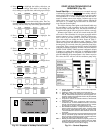
procedures in the Transfer Refrigerant from Storage
Tank to Chiller section, Steps 1a-e, page 59.
Never charge liquid refrigerant into the chiller if
the pressure in the chiller is less than 68 psig
(469 kPa) for HCFC-22 and 35 psig (241 kPa) for
HFC-134a. Charge as a gas only, with the cooler
and condenser pumps running, until this pressure
is reached, using PUMPDOWN LOCKOUT and
TERMINATE LOCKOUT mode on the PIC. Flash-
ing of liquid refrigerant at low pressures can cause
tube freezeup and considerable damage.
c. Leak test chiller as outlined in Steps 3-9.
2. If the pressure readings are abnormal for chiller
condition:
a. Prepare to leak test chillers shipped with refrigerant
(Step 2h).
b. Check for large leaks by connecting a nitrogen bottle
and raising the pressure to 30 psig (207 kPa). Soap
test all joints. If the test pressure holds for 30 minutes,
prepare the test for small leaks (Steps 2g-h).
c. Plainly mark any leaks which are found.
d. Release the pressure in the system.
e. Repair all leaks.
f. Retest the joints that were repaired.
g. After successfully completing the test for large leaks,
remove as much nitrogen, air, and moisture as pos-
sible, given the fact that small leaks may be present in
the system. This can be accomplished by following
the dehydration procedure, outlined in the Chiller
Dehydration section, page 47.
h. Slowly raise the system pressure to a maximum of
210 psig (1448 kPa) but no less than 68 psig (469 kPa)
for HCFC-22, 35 psig (241 kPa) for HFC-134a by add-
ing refrigerant. Proceed with the test for small leaks
(Steps 3-9).
3. Check the chiller carefully with an electronic leak detec-
tor, halide torch, or soap bubble solution.
4. Leak Determination — If an electronic leak detector
indicates a leak, use a soap bubble solution, if possible,
to confirm. Total all leak rates for the entire chiller. Leak-
age at rates greater than 1 lb/year (0.45 kg/year) for the
entire chiller must be repaired. Note total chiller leak rate
on the start-up report.
5. If no leak is found during initial start-up procedures, com-
plete the transfer of refrigerant gas from the storage tank
to the chiller (see Pumpout and Refrigerant Transfer Pro-
cedures, Transfer Refrigerant from StorageTank to Chiller
section, Step 1e, page 59). Retest.
6. If no leak is found after a retest:
a. Transfer the refrigerant to the storage tank and
perform a standing vacuum test as outlined in the
Standing Vacuum Test section, this page.
b. If the chiller fails this test, check for large leaks
(Step 2b).
c. Dehydrate the chiller if it passes the standing vacuum
test. Follow the procedure in the Chiller Dehydration
section. Charge chiller with refrigerant (see Pumpout
and Refrigerant Transfer Procedures, Transfer Refrig-
erant from Storage Tank to Chiller section, Steps 1a-e
or page 59).
7. If a leak is found, pump the refrigerant back into the stor-
age tank, or if isolation valves are present, pump into the
non-leaking vessel (see Pumpout and Refrigerant Trans-
fer procedures section).
8. Transfer the refrigerant until chiller pressure is at
18 in. Hg (40 kPa absolute).
9. Repair the leak and repeat the procedure, beginning from
Step 2h to ensure a leaktight repair. (If chiller is opened
to the atmosphere for an extended period, evacuate it be-
fore repeating leak test.)
Standing Vacuum Test — When performing the stand-
ing vacuum test, or chiller dehydration, use a manometer or
a wet bulb indicator. Dial gages cannot indicate the small
amount of acceptable leakage during a short period of time.
1. Attach an absolute pressure manometer or wet bulb in-
dicator to the chiller.
2. Evacuate the vessel (see Pumpout and Refrigerant Trans-
fer Procedures section, page 59) to at least 18 in. Hg vac,
ref 30-in. bar (41 kPa), using a vacuum pump or the
pumpout unit.
3. Valve off the pump to hold the vacuum and record the
manometer or indicator reading.
4. a. If the leakage rate is less than 0.05 in. Hg (.17 kPa) in
24 hours, the chiller is sufficiently tight.
b. If the leakage rate exceeds 0.05 in. Hg (.17 kPa) in
24 hours, repressurize the vessel and test for leaks. If
refrigerant is available in the other vessel, pressurize
by following Steps 2-10 of Return Refrigerant To
Normal Operating Conditions section, page 61. If not,
use nitrogen and a refrigerant tracer. Raise the vessel
pressure in increments until the leak is detected. If
refrigerant is used, the maximum gas pressure is
approximately 120 psig (827 kPa) for HCFC-22,
70 psig (483 kPa) for HFC-134a at normal ambient
temperature. If nitrogen is used, limit the leak test pres-
sure to 230 psig (1585 kPa) maximum.
5. Repair leak, retest, and proceed with dehydration.
43


















